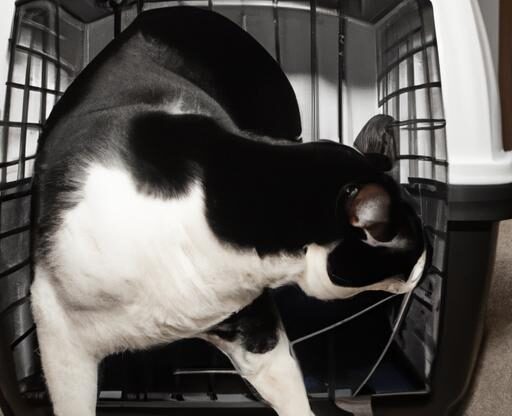Cat Won’t Get into Carrier: Safely Transporting Your Feline Friend
Every cat owner knows the challenges of transporting their furry companions, especially when they adamantly refuse to enter their carriers. Picture this: you’re all set for a vet visit or a family vacation, but your cat has planted themselves firmly on the ground, claws gripping the carpet. Frustration sets in as you wonder, “Why won’t my cat get into the carrier?”
Understanding the Reasons Behind This Behavior
Before we delve into the solutions, let’s explore why your cat might be so resistant to entering their carrier. Cats are known for their independent nature and aversion to confinement. The carrier represents a confined space, which can trigger their natural instincts to resist and escape. Additionally, negative past experiences, such as uncomfortable car rides or stressful vet visits, may have created an association between the carrier and fear or discomfort.
The Importance of Safely Transporting Your Cat
Ensuring your cat’s safety during transportation is crucial. Even if your feline friend protests, it’s essential to find ways to get them into the carrier. Unrestrained cats in the car pose a significant risk to both themselves and the driver. They can become a distraction, potentially leading to accidents or injuries.
To make the process smoother and stress-free for both you and your cat, we’ll explore practical techniques, tips, and strategies in the following sections. From preparing the carrier to creating a calm environment, we’ll guide you through the steps to encourage your cat to willingly enter their carrier. Remember, patience and persistence are key when it comes to coaxing your cat into the carrier.
So, if you’ve been struggling with a cat who won’t get into their carrier, fear not! Together, we’ll uncover the secrets to safely transporting your feline friend. Let’s embark on this journey toward stress-free travels with your beloved cat by your side.
Stay tuned for the next section, where we’ll discuss how to prepare the carrier and make it a comfortable space for your feline friend.
Understanding Your Cat’s Fear
Cats’ Natural Instincts and Their Aversion to Confinement
Cats are inherently independent creatures, with a strong instinctual drive for freedom. They cherish their territory and may view confinement in a carrier as a threat to their autonomy. The carrier’s enclosed space can trigger their fight-or-flight response, causing them to resist entering it.
Previous Negative Experiences and Associating the Carrier with Them
Negative experiences in the past can leave a lasting impression on your cat’s psyche. Uncomfortable car rides or distressing vet visits may have created a negative association between the carrier and fear or discomfort. Understandably, your cat may be reluctant to relive those unpleasant moments, leading to their refusal to enter the carrier.
Fear of the Unknown and Unfamiliar Environment
Cats thrive on familiarity and routine, making new environments and experiences a source of anxiety for them. The carrier represents an unfamiliar space, filled with unknown sounds, scents, and sights. This unfamiliarity can trigger fear and hesitation in your cat, causing them to resist entering the carrier.
By acknowledging and understanding these underlying factors, we can approach the challenge of getting your cat into the carrier with compassion and empathy. In the next section, we will discuss how to prepare the carrier in a way that addresses your cat’s fears and makes it a more inviting space for them. Stay tuned to discover the secrets of creating a comfortable and enticing carrier for your feline friend.
Preparing the Carrier
Choosing the Right Carrier and Making it Comfortable
When it comes to transporting your cat, selecting the right carrier is paramount. Opt for a carrier that is sturdy, secure, and spacious enough for your cat to move comfortably. Consider carriers with ample ventilation and a removable top for easy access during vet visits.
To make the carrier more inviting, create a cozy and familiar environment inside. Line the carrier with a soft blanket or bedding that carries the scent of home. Cats are attracted to familiar scents, so using bedding they regularly sleep on can help alleviate anxiety and make the carrier feel like a safe haven.
Familiarizing Your Cat with the Carrier in Advance
Introducing your cat to the carrier well in advance of your travel date can work wonders. Start by leaving the carrier out in a common area of your home, with the door open, allowing your cat to explore it freely. Place treats, toys, or a comfortable bedding inside to entice your cat to investigate.
Gradually, encourage your cat to spend more time inside the carrier. You can begin by feeding them near the carrier, gradually moving their food bowl closer each day. This helps create positive associations with the carrier and reduces any fear or anxiety they may have.
Using Positive Reinforcement Techniques to Create a Positive Association
Positive reinforcement is key to making the carrier a positive and inviting space for your cat. Reward your cat with treats, praise, or playtime whenever they willingly enter or stay inside the carrier. This encourages them to associate the carrier with positive experiences and reduces their reluctance to enter.
Consider using pheromone sprays or calming aids designed specifically for cats. These products emit relaxing scents that can help soothe your cat’s anxiety during the carrier training process.
By preparing the carrier, familiarizing your cat with it, and employing positive reinforcement techniques, you can transform the carrier from a source of fear into a safe and comfortable space for your feline friend. Next, we’ll explore how to create a calm environment to further alleviate your cat’s stress during travel.
Creating a Calm Environment
When it comes to getting your cat into the carrier, creating a calm environment is crucial. Cats are sensitive creatures, and a peaceful atmosphere can go a long way in alleviating their stress and anxiety. Here are some effective strategies to help you achieve a serene setting for your feline friend.
Reducing Stress and Anxiety by Creating a Peaceful Atmosphere
Start by selecting a quiet and comfortable room where you can prepare the carrier. This room should be a safe haven for your cat, free from distractions and loud noises. Close the doors and windows to minimize external sounds that might startle or agitate your kitty.
Consider playing soft, calming music or using a white noise machine to drown out any sudden noises that could trigger anxiety. The gentle melodies can help create a soothing environment, putting both you and your cat at ease.
Minimizing Loud Noises and Sudden Movements
Cats are highly sensitive to loud noises and sudden movements. When it’s time to coax your cat into the carrier, ensure the surroundings remain tranquil. Avoid any activities that might startle or disturb your cat during this process.
If you have other pets or children in the house, keep them in a separate room or outside the carrier area. By minimizing potential disturbances, you provide your cat with a sense of security, making it easier for them to approach the carrier.
Utilizing Pheromone Sprays or Calming Aids
Pheromone sprays, such as Feliway, mimic the natural calming scents that cats produce. These sprays can be applied to the carrier or the surrounding area to create a familiar and reassuring scent for your cat. The calming aroma helps alleviate anxiety and encourages your feline friend to approach the carrier more willingly.
Additionally, there are various calming aids available in the market, including treats or supplements that promote relaxation in cats. Consult with your veterinarian to determine which calming aids may be suitable for your cat’s specific needs.
By creating a calm environment, you set the stage for a successful carrier introduction. In the next section, we’ll explore techniques to encourage your cat’s entry into the carrier, using treats and positive reinforcement. Stay tuned for valuable tips on making the carrier an inviting space for your feline companion.
Techniques to Encourage Entry
Encouraging your cat to willingly enter the carrier may seem like a daunting task, but fret not! With the right techniques, you can make the carrier an inviting and desirable space for your feline friend. Let’s explore some effective methods to entice your cat into their carrier.
Using Treats and Favorite Toys to Entice Your Cat
What better way to motivate your cat than with their favorite treats and toys? Start by placing some enticing treats inside the carrier, making it an irresistible treasure trove. Entice your cat by using treats they absolutely adore, ensuring they associate the carrier with positive experiences. You can also try scattering treats around the carrier to pique their curiosity and gradually lead them inside.
Toys can also be powerful tools for persuasion. Engage your cat’s natural hunting instincts by placing their beloved toys inside the carrier. The sight and scent of their favorite playthings will make the carrier appear more appealing, enticing them to explore and eventually enter willingly.
Gradual Desensitization and Counter-Conditioning Methods
For cats with deep-seated fear or anxiety towards carriers, a gradual desensitization approach can work wonders. Start by leaving the carrier in a familiar and comfortable area of your home, allowing your cat to acclimate to its presence. Leave the carrier door open, creating an inviting space for them to investigate at their own pace. Gradually increase their exposure to the carrier by placing treats, toys, or even their bedding inside.
Counter-conditioning techniques can also aid in changing your cat’s negative perception of the carrier. Pair positive experiences with the carrier by offering treats, praise, or gentle petting whenever they approach or show interest in it. Over time, your cat will associate the carrier with positive emotions, easing their reluctance to enter.
Patience and Persistence in the Training Process
Remember, training your cat to enter the carrier requires patience and persistence. Cats are creatures of habit, and it may take time for them to feel comfortable and trust the carrier as a safe space. Avoid rushing the process and allow your cat to progress at their own pace. Celebrate small victories along the way and reward any positive behavior, no matter how small.
Stay tuned for the next section, where we’ll discuss creating a calm environment to alleviate your cat’s stress and anxiety during the carrier training process. Together, we’ll pave the way for stress-free journeys with your feline companion.
Conclusion
In conclusion, understanding and addressing the reasons behind your cat’s reluctance to enter their carrier is crucial for safe and stress-free transportation. By acknowledging their natural instincts, previous negative experiences, and fear of the unknown, you can approach the situation with empathy and patience.
Throughout this article, we’ve explored various strategies to encourage your cat to willingly enter their carrier. From preparing the carrier and creating a calm environment to using positive reinforcement techniques and seeking professional help when necessary, you now have a toolkit of effective methods at your disposal.
Remember, building a positive association with the carrier takes time and consistency. Be sure to start the training process well in advance of your planned trips to allow ample opportunity for your cat to adjust and feel comfortable.
Transporting your cat safely is not only essential for their well-being but also for your peace of mind. By following the tips and techniques shared here, you can overcome the challenge of a cat who won’t get into their carrier and ensure stress-free journeys together.
So, take a deep breath, gather your patience, and embark on this journey with your feline companion. With understanding, love, and a little bit of training, you can conquer the carrier dilemma and create a harmonious travel experience for both you and your cat.
Safe travels!





